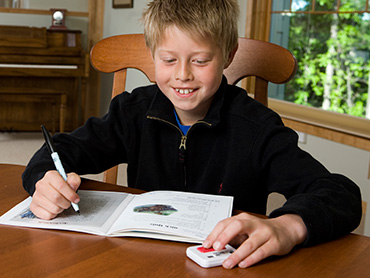A recent audio documentary and corresponding article from American Public Media highlight a serious problem in our country: According to the National Assessment of Educational Progress, more than 60 percent of American fourth graders are not proficient readers, and that statistic has held since testing began in the 1990s. The documentary is called Hard Words: Why aren’t kids being taught to read?, and we encourage you to check it out.
 How well children learn to read tends to have a profound impact on the trajectory of their lives. Kids who don't learn to read well are less likely to complete high school and more likely to end up in poverty or the criminal justice system. Because the stakes are so high, the best approach to reading instruction has long been a hot—and fraught—topic in education.
How well children learn to read tends to have a profound impact on the trajectory of their lives. Kids who don't learn to read well are less likely to complete high school and more likely to end up in poverty or the criminal justice system. Because the stakes are so high, the best approach to reading instruction has long been a hot—and fraught—topic in education.
According to the American Public Media piece, two schools of thought have emerged from the debate. One is that learning to read is a natural process, and when children are surrounded by good books and a literacy-rich environment, literacy will catch. The second school of thought is that reading is not natural for the human brain and needs to be explicitly taught, building from a strong foundation of phonemic awareness and phonics.
To try to get to the bottom of the question, many researchers have done studies on how the human brain achieves literacy. In the year 2000, Congress even got involved by conducting a National Reading Panel. Scientific evidence has confirmed that, when reading is taught and phonics is a crucial component of the instruction, students tend to learn to read well.
The American Public Media documentary asserts that many educators are not taking a research-based approach to reading instruction, and because of this, millions of students are being set up to fail—which may explain why our nation’s literacy statistics are so grim.
We at Read Naturally agree that reading instruction should align with research, which is why our programs incorporate the five key components of reading instruction as identified by the National Reading Panel and place a strong emphasis on phonics. Beyond this, several independently conducted studies of our programs have proven the effectiveness of our approach. Click here to learn more about the robust body of scientific research behind our products.
Even so, we continue in our mission here at Read Naturally for reasons science can’t exactly measure. We show up to work each day because we have witnessed, time and again, how our programs change students’ lives for the better. We have sat beside thousands of struggling readers who lacked confidence in their abilities and then went on to soar. Scores of teachers, across the nation and all over the world, report the same phenomenon. Simply put, students who use Read Naturally programs come to experience the joy of reading for the first time in their lives. We believe there is no greater measure of a program’s effectiveness than that.
We are committed to improving our nation’s literacy statistics, and, more importantly, improving students’ lives. We would love to partner with you in this effort. Click here to check out our offerings and begin a free trial of any of our programs.
 Share your student’s success story—nominate him or her for our Star of the Month award. Win a Barnes & Noble gift card for the student and a Read Naturally gift certificate for your class!
Share your student’s success story—nominate him or her for our Star of the Month award. Win a Barnes & Noble gift card for the student and a Read Naturally gift certificate for your class!
Post a New Comment